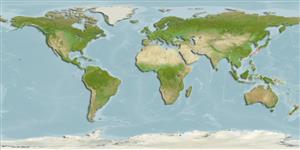Elasmobranchii (sharks and rays) >
Carcharhiniformes (Ground sharks) >
Scyliorhinidae (Cat sharks) > Scyliorhininae
Etymology: Cephaloscyllium: cephalus, from kephale (Gr.), head, referring to its very broad and depressed head; skylion, Greek for dogfish or small shark. (See ETYFish); stevensi: In honor of John Stevens (b. 1947), whose 1994 work (with Peter Last) on Australian sharks was the “foundation for research that led to the descriptions of 37 new chondrichthyan fishes, including 11 species of Cephaloscyllium”. (See ETYFish).
More on authors: Clark & Randall.
Environment: milieu / climate zone / depth range / distribution range
Ecology
Marine; pelagic-neritic; depth range 240 - 274 m (Ref. 86282). Tropical
Western Pacific: Papua New Guinea.
Size / Weight / Age
Maturity: Lm ? range ? - ? cm
Max length : 66.0 cm TL (female)
Short description
Identification keys | Morphology | Morphometrics
Similar to its congeners, this species is most easily distinguished by its color pattern: gray-brown above, whitish ventrally, mottled with brown and whitish spots of variable size over head and body, including ventrally; 6 large dark brown saddle blotches dorsally on head and body and 3 on caudal fin; first four dorsal dark blotches connecting or leading obliquely to other dark blotches below; small white spots most distinct within or at edges of dark brown blotches (Ref. 86282).
Life cycle and mating behavior
Maturities | Reproduction | Spawnings | Egg(s) | Fecundities | Larvae
Clark, E. and J.E. Randall, 2011. Cephaloscyllium stevensi: a new species of swellshark (Carcharhiniformes: Scyliorhinidae) from Papua New Guinea. aqua, Int. J. Ichthyol. 17(1):23-34. (Ref. 86282)
IUCN Red List Status (Ref. 130435)
Threat to humans
Harmless
Human uses
Tools
Special reports
Download XML
Internet sources
Estimates based on models
Preferred temperature (Ref.
123201): 8.9 - 11.8, mean 9.1 °C (based on 6 cells).
Phylogenetic diversity index (Ref.
82804): PD
50 = 0.5000 [Uniqueness, from 0.5 = low to 2.0 = high].
Bayesian length-weight: a=0.00263 (0.00139 - 0.00497), b=3.21 (3.04 - 3.38), in cm total length, based on LWR estimates for this (Sub)family-body shape (Ref.
93245).
Trophic level (Ref.
69278): 4.1 ±0.5 se; based on size and trophs of closest relatives
Resilience (Ref.
120179): Low, minimum population doubling time 4.5 - 14 years (Preliminary low fecundity).
Fishing Vulnerability (Ref.
59153): Moderate to high vulnerability (46 of 100).
